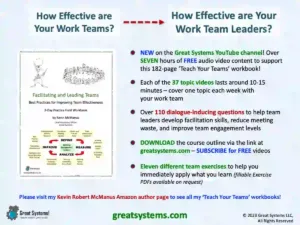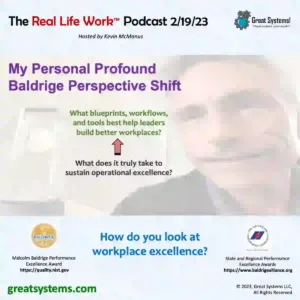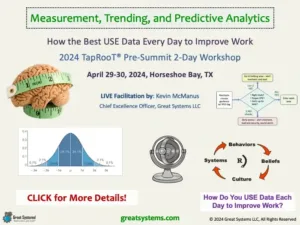How do empowerment, engagement, and creativity drive innovation in your workplace?
Empowerment, Engagement, and Creativity Drive Innovation
Empowerment, engagement, and creativity drive innovation. However, we often fail to make such connections. Organizations need innovation to sustain a competitive advantage in today’s world of work. That said, too many teams and organizations struggle to sustain improvement, let alone innovation.
Most work system designs do not promote high, sustained levels of empowerment, let alone engagement and creativity. This post explores the connection between these three factors and innovation rates. More importantly, it includes concrete work system design changes to help you realize higher levels of innovation across your organization.
Empowerment Gives People the Chance to Contribute
What percent of your team, let alone your organization, do you truly empower to help make a difference? In too many companies, most people show up, do their job (which leaders often tightly control and limit in scope), and go home. General Electric, Allied Signal, and Motorola had success with their Six Sigma initiatives. Others failed to replicate that success. How come? One key factor is that GE and others designed their work systems to consistently empower an ultrahigh percentage of their workforce.
Do the math. You can’t generate innovation after innovation unless you give people more freedom to learn, work with others, and expand their work horizons. Ideally, it is part of your leadership development process, strategic plan, capital and expense budgets, and ultimately, your culture to enhance and expand empowerment levels. All too often, leadership egos and actions keep great ideas from spawning into innovations.
Do Your Job Designs, Measures, and Compensation Plans Encourage Empowerment?
I was fortunate to learn early on in my career that empowerment works because everyone is great at something. I worked in companies where leaders were expected to both be part of improvement teams and let others lead those teams. Doing so was part of their job description. They were evaluated relative to those defined expectations.
More importantly, leaders must be taught how, and required to, let people make decisions that lead to consistent customer delight. “I’ll have to check with my supervisor” is not heard very often in organizations with true empowerment.
This does not happen by chance, however. The opportunity to contribute must be built into your job descriptions, your performance measures, and your compensation plan designs. When given the chance, people will make the right choices and do great things. How well is your company built to support, encourage, and reward empowerment?
A suggestion box is not enough. In fact, suggestion boxes are often the kiss of death when it comes to empowerment and innovation potential. Simply put, the designs of our jobs, processes, and systems don’t include enough time to effectively evaluate, let alone install, all of the great ideas such an approach initially generates. All too often, the exact opposite is the case. Leaders raise expectations for change, and then dash them.
LISTEN MORE: Check out my ‘How to Increase Work Team Engagement’ Real Life Work PODCAST
Engagement Gives People a Reason to Contribute
How many of your people care about their jobs beyond the paychecks that go into their bank accounts? How many of your people go the extra mile to help make the organization better?
What percentage of your staff has bounced as soon as a better job offer comes along? Engagement won’t happen just because the word is part of a mission statement or the biggest word in the company’s word bubble poster.
Engagement happens when people feel like their leaders care about both them and their ideas. The systems necessary for true empowerment drive the potential for engagement, but every leader has to support those systems.
EACH team leader must consistently treat their people with respect. Plus, they must consistently encourage people to truly make a difference. Your core measures of leadership effectiveness should include empowerment and engagement dimensions. Use both formal and informal methods to regularly assess dimension-specific support.
EXPLORE MORE: How to Measure Employee Ownership
True Team Engagement is MORE than ‘Mere Satisfaction’
Keep in mind that both internal and external customer engagement goes way beyond ‘mere’ satisfaction. Effective engagement results in people who will serve as advocates for the organization, its mission, and its values.
Retention rates, absenteeism rates, and idea submission rates are all indicators. Leaders must design each job so that multiple vehicles exist for engagement. Perhaps more importantly, leaders must be taught how to perform their jobs in a manner that encourages engagement vehicle use.
Creativity Turns Great Ideas into an Innovations
How many of your people are creative? In reality, that percentage is much higher than one thinks. However, the ‘prevailing system of management’ often hamstrings our creative abilities. As Dr. Deming once said, “The forces of destruction begin with toddlers.” We put people into boxes and expect them to stay there.
We fail to effectively empower our people to try new things or do things differently. They miss the chance to learn and contribute in ways that they never thought possible in a workplace.
Leaders encourage and enable creativity more than teach it. Skills to enhance one’s creativity might be readily available, but do your leaders encourage skill development as often as they should? Even when they are encouraged and developed, restrictive work systems, and overly restrictive leadership practices, prevent people from putting their ideas to work.
How often do you recognize and reward creativity in your company? How often do you expect creative contributions as part of one’s job description?
LEARN MORE: How to Measure and Improve Your Job Design Work System
Eight Concrete Ideas to Help Empowerment, Engagement, and Creativity Drive Innovation
Several systematic changes to help foster the growth of these three concepts can be found among the above paragraphs. Here is a summary list to help you create your own plan. How can you change your workplace into one where innovation occurs regularly?
#1: Benchmark those companies who have demonstrated the ability to effectively empower and engage their workforce
Recipients of the Malcom Baldrige Quality Award provide one great source of ideas in these areas. The design of the criteria recognizes companies who systematically empower and engage their staff to help foster excellence and innovation. Study these work system designs to avoid reinvention of the wheel.
#2: Redesign jobs to provide time for formal team-based activities
Workplace job descriptions and expense budgets include time for formal empowerment activities in high performance companies. Systematic empowerment examples include process improvement teams and pre-shift work group meetings. Other examples include focus groups (safety committees, recognition teams, and planning teams) and company-sponsored volunteerism.
#3: Use social media, intranet pages, and other technology to provide ways for all team members to share ideas and build relationships
Your 21stcentury company bulletin boards can come in many forms. More importantly, you can design them to help facilitate high levels of two-way communication. The people who do the work are your best sources if you want to identify process improvement ideas and process barriers. Give them effective ways to share their ideas. Also, provide ‘bottom up’ feedback on a regular basis.
#4: Build formal skills training with an innovation focus into all jobs
Most formal education people receive in life offers little on how empowerment, engagement, and creativity drive innovation. Common ‘best practice’ topics include how to manage group dynamics and facilitate group events. Others focus on how to understand communication styles, and enhance creativity and innovation. What percentage of your staff competency maps include these skills?
EXPLORE MORE: How to Measure and Improve Your Training and Learning Work System
#5: Measure empowerment, engagement, and creativity levels at least annually as part of a formal engagement survey
Many companies now conduct culture / satisfaction / engagement surveys on a less frequent basis, such as every other year. They often base their logic on cost versus the low level of change the organization experiences between annual surveys. However, today’s technology allows you to conduct short, pop-up surveys very often. The low rate of change problem is often more of a ‘no time for projects’ job design issue.
#6: Include measures of leadership support in your annual survey
We tend to consistently do the work that we measure. Use of bottom-up leadership support feedback from each leader’s work team members results in behavior change. Check out the Survey-Feedback-Action process used by FedEx for a great work systems model. The addition of a Leadership Index to your annual assessment offers one way to obtain such measures.
#7: Formally recognize anyone who contributes to meaningful process change
What percentage of your workforce receives formal recognition for their contributions each year? How effective are your formal recognition approaches from your internal customer’s perspective?
Also, assess and improve your formal recognition plans over time to help maintain their effectiveness. The use of daily, consistent, and meaningful informal recognition from leaders at all levels must also support the formal process.
LEARN MORE: Does Your Team Structure Drive Operational Excellence?
#8: Stop the use of processes that discourage empowerment, engagement, and creativity
‘One winner’ recognition programs such as ‘Employee of the Month’ discourage more people than they positively motivate. Similarly, motivation shifts occur when we tolerate poor performance or compensate only a few people for the work of many. Finally, when we fail to provide skill development paths to all staff, we also drive down empowerment, engagement, and creativity levels.
Keep improving!
Kevin McManus, Chief Excellence Officer, Great Systems
WATCH over 50 kaizen and workplace health improvement videos on my Great Systems YouTube channel.
CHECK OUT my ‘Teach Your Teams’ workbooks on Amazon.com
LIKE Great Systems on Facebook
© Copyright 2024, Great Systems LLC, All Rights Reserved







